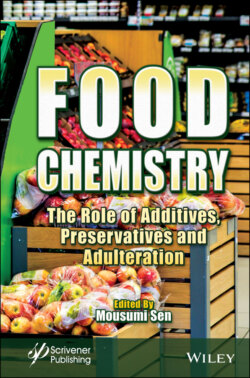Читать книгу Food Chemistry - Группа авторов - Страница 66
2.1 Introduction
ОглавлениеThroughout history, human beings are cultivating, harvesting food, and processing it with sophisticated methods. In ancient Greece, bread, olive oil, and wine were three products. These were the products in which the hardly edible raw materials were transformed to safe, nutritious, and stable food. Historically, there is a tradition to add ingredients or substance to foods for a particular function like ancient Egyptian used spices in food for flavoring. They used yeast in bread as leavening agent. They also used coriander and castor oil for medicinal application, cosmetics, and as preservative. Color was also used in candy and wine. In Japan, during 8th century, color was used in soybean and cakes.
Foods are the substances that are consumed in solid and/or liquid form to get nutritional benefits. Food additives are used in food from ancient times like salt is used in preservation of meat, herbs and spices are used for the improvement of food flavor, sugar is used as a preservative of fruits, and pickles were prepared with spices and vinegar. Use of processed food is increasing day by day. As a result, there is an increased use of food additives and preservatives. Additives are any substances that are used at any stage of food processing with various objective like the following:
i. To improve the keeping quality of the final product.
ii. To improve the appearance of the product.
iii. To improve the nutritional value of the product.
The additives might be natural or synthetic. Natural additives are extracted from any natural source like plant, animal, or mineral. Synthetic additives are synthesized by chemical or enzymatic reaction. These synthetic additives might be either identical to any natural compound or a pure synthesized compound. Table 2.1 gives an idea about the source of different food additives.
The additives might be added directly or indirectly in to food product. When the additives are added with particular intention and mentioned in the food label, they are called direct additives. Sometimes, food materials are exposed to additives by chance during processing, storage, or packaging. They are called indirect additives.
Preservatives are substances which is able to retard the growth of microorganism or able to mask the deterioration caused by microorganism. Preservatives like salt, sugar, herbs, spices, and vinegar are used from centuries [1].
There are hundreds of food additives currently used in the food industry. FDA maintains a list of over 3,000 additives in its database. Product label contains list of additives along with other ingredients. As per convention, all the additives are mentioned in the list with their category name along with their specific name or with a number preceded by E number. Letter E indicates that the additive is included in the European list of food additives. Countries outside Europe use either number or name in the food labels. The E number does not indicate whether the additive is a natural or synthetic compound but category of the compound can be identified with the E number. For example, coloring agents have E number between 100 and 180, 500, to 1,520, which includes acids, alkalis, flavor enhancer, and additives with various other functions.
Table 2.1 Food additives and its sources.
| Source of food additives | Example of food additives |
|---|---|
| Plant origin | i. Acidulant as tartaric acid from fruitii. Color from fruits and vegetablesiii. Thickening agent from seaweed, fruit and seeds |
| Nature identical product | i. Antioxidant Ascorbic acid from fruitii. Tocopherol from vegetable oiliii. Food color carotenoid |
| Additives obtained by modification of natural substances. | i. Emulsifier from edible oilsii. Thickening agent as modified starch, modified celluloseiii. Sweetener as sorbitol |
| Man-made product | i. Antioxidant like BHAii. Color like Quinoline yellowiii. Sweetener like saccharin |
Risk assessment of any new food additives is carried out by autonomous international committee JECFA (Joint FAO/WHO Expert Committee on Food Additives). The committee assesses the health risk of additives on human being since 1956. The committee gives approval to only those additives that are found having no appreciable health risk to consumer. National authorities on the basis of JECFA assessment or national assessment approve the level of additives for a particular food. To use a new food additive in the processed food, the manufacturer needs to get its approval from national or international authorities. For that purpose, they need to file a petition to FDA for approval. The petition includes proper evidence that the substance is safe for they ways it is used. To approve the new additives under European Union, the procedure has four parts as follows:
a. Chemistry and specification of the additive: The additive is identified as per their origin, as a single, complex mixture, derivative of plant source, or synthesized material.
b. Existing authorization and approval: It is found that whether the additive already exists and what are the previous data of the additive.
c. Proposed use and exposure assessment: Estimation of dietary exposure based on proposed use and proposed age level of the person.
d. Toxicological study: Toxicological study regarding the effect of additive on the basis of in vitro and in vivo.
After approval of the new additive, the FDA issues regulation for the additive that includes the type of food in which it can be used, the maximum amount it can be used, and how it should be mentioned on food labels.
